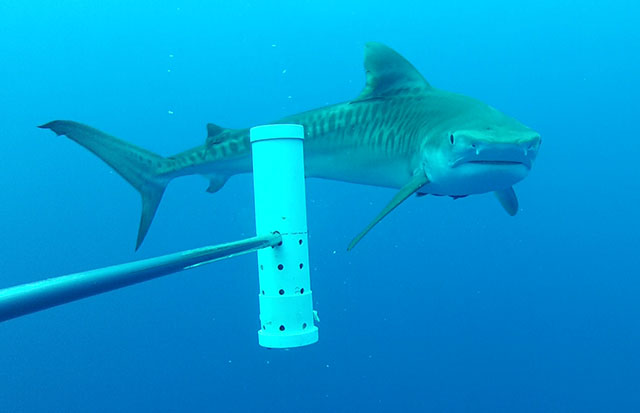| Galeocerdonidae (Tiger sharks) |
| 750 cm TL (male/unsexed); max.weight: 807 kg; max. reported age: 50 years |
|
benthopelagic; brackish; marine; depth range 0 - 800 m, oceanodromous |
| Circumglobal in tropical and temperate seas. Western Atlantic: Massachusetts, USA to Uruguay, including Gulf of Mexico and the Caribbean. Eastern Atlantic: Iceland to Angola. Indo-Pacific: Persian Gulf (Ref. 68964), Red Sea and East Africa to Hawaii and Tahiti, north to southern Japan, south to New Zealand. Eastern Pacific: southern California, USA to Peru, including the Revillagigedo, Cocos, and Galapagos islands. Highly migratory species. |
|
Dorsal spines (total): 0-0; Dorsal soft rays (total): 0-0; Anal spines: 0-0; Anal soft rays: 0-0. This species is a huge, vertical tiger-striped shark with a very short or broad, bluntly rounded snout (its length much less than width of mouth), long upper labial furrows (about as long as snout, reaching front of eyes), a big mouth with large, saw-edged, cockscomb-shaped teeth (coarsely serrated with outer edges deeply notched and tips directed obliquely outward); spiracles small, slit-like, but easily visible, caudal keels low. Colour of back dark grey or greyish brown with vertical dark grey to black bars and rectangular spots often forming bars on sides and fins, but fading with growth (Ref. 5578, 9997). |
| Usually found near surface to depths of 140 m (Ref. 26938); in Tahiti from 0-350 m (Ref. 89972). Occurs on or adjacent to continental and insular shelves, frequenting river estuaries, off wharves and jetties in harbors, and in coral atolls and lagoons (Ref. 244). Bottom-associated, sometimes pelagic (Ref. 58302). Also off oceanic islands far from other islands and continental land masses (Ref. 244). Makes excursions in the open ocean, but is not a truly oceanic species (Ref. 244). Nocturnal feeder on other sharks, rays, bony fishes, marine mammals, tortoises, seabirds, sea snakes, squids, gastropods, crustaceans, detritus (Ref. 9997), also including toxic or armored fish species such as Lactoria cornuta or Diodon hystrix, porpoises, whales, sea turtles, cephalopods, domestic animals and humans (Ref. 37816). It also feeds on carrion and garbage, including cans, pieces of metal and burlap bags (Ref. 26938). Second only to Carcharodon carcharias in recorded attacks on humans with at least 27 documented attacks sourced to it . One specimen, reportedly taken off Indo-China, weighed 3,110 kg and measured 740 cm (Ref. 9987). May be kept in an aquaria, but does not last for more than a few months (Ref. 244). Ovoviviparous (Ref. 50449). Up to 80 young of 51 to 104 cm are born per litter (Ref. 1602). Valued for its meat, fins, hide and liver oil (Ref. 9997) and also for its jaws and cartilage (Ref. 58048). Often used for fishmeal (Ref. 9997). Utilized fresh, dried-salted, smoked and frozen (Ref. 9987). Species from the Persian Gulf and Oman Sea has a max size of 750 cm TL (Ref. 47613). |
|
Near Threatened (NT); Date assessed: 10 August 2018 (A2bd+3d) Ref. (130435)
|
| traumatogenic |
|
Also Ref. 89942, 8879. |
Source and more info: www.fishbase.org. For personal, classroom, and other internal use only. Not for publication.

